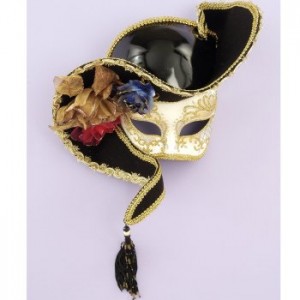Mardi Gras Masks
Love to party? Then get your groove on this Mardi Gras! The big day in usually in February, so you’ll want to be ready with the perfect costume—and the perfect costume calls for the perfect mask. Here’s how to make or select a gorgeous Mardi Gras disguise this year.
What It’s All About
But first…what’s the fuss about? Mardi Gras (French for “fat Tuesday”) began as a Catholic celebration beginning on Twelfth Night (Jan. 6) and ending the Wednesday before Lent.
Brought to the U.S. in the 18th century by the French under the name Carnival, Mardi Gras was a way for religious observers to blow off steam before the more restricted Lent season began. Partly for that reason, revelers paraded about or attended a masque wearing disguises and costumes (people tend to feel less inhibited when their identities were secret).
Another fascinating reason for wearing a mask during Mardi Gras is the history of Krewes, or secret societies—the original sponsors of Mardi Gras as an official city event. Often they stood disguised atop the parade floats, tossing trinkets down, including beads, still a popular tradition today.
Mardi Gras Mask Basics
The idea behind a Mardi Gras mask is to be secretive—but not too much. In other words, the look is sly, mysterious, playful and fun. It can be a full-face mask or (more frequently) it can cover the eyes and the sides of the face, often with the use of feathers.
Traditional Mardi Gras colors are purple, green and gold, so if you’re stuck as far as what to choose, start with these. However, the holiday is a free-for-all, and any colors can be chosen for your mask.
Mask-Making Supplies
Here are the supplies you’ll need to create a mask that will make you the belle (or beau!) of the masqued ball:
- Craft foam or cardboard large enough for the entire back of the mask (colored, if desired)
- Thin wooden dowel (if you will be holding the mask up to your face)
- Elastic band and stapler with staples (if you will be wearing the mask over your head)
- Paints and a paintbrush, if desired
- Magic markers, if desired
- Decorations such as feathers, beads, glitter, silk flowers and shells
- A pencil or piece of chalk
- Heavy duty craft glue; heavy-duty tape if desired; scissors or a utility knife
Creating the Mask
Look online using your favorite search engine for Mardi Gras mask patterns. (Here’s a fun-looking one here.) You’ll find a huge variety to choose from, including traditional styles such as the Venetian mask. Print out your favorite.
- With the pencil or chalk, draw the mask pattern onto your craft foam or cardboard. Cut out the shape.
- Glue the dowel to the rear of the mask on the lower right or left-hand side if the mask will be hand-held. (You can add extra insurance here by taping over the dowel as well; this won’t show when you’re holding the mask up to your face.)
- If you will be creating a mask without a holder, measure a piece of elastic around the back of your head and cut it to size. Staple the elastic to fit behind each ear.
- Paint the front of the mask if desired for a background color.
- Decorate the front of the mask using glitter, shells, beads, magic markers or anything else that strikes your fancy. One essential for any Mardi Gras mask is a fluff of feathers, usually placed above one eye, but you can add as many feathers as you wish on any part of the mask for a unique look.
Allow the project to dry completely, add a fanciful costume, and you’re all set for the parade or your party!
